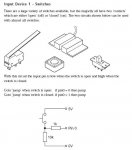Just 2 quick questions.
How do I have an input give power instead of being ground like normal? For example. I have pin--------switch--------ground. How do I make it so that when the switch is pressed the pin detects it.
How do I have no connection to something? Like its not giving a Low signal or a high signal its just disconnected.
pin----LED------ground.
........|
........|
some over thing sending positive to the LED
See if I send a low signal then the LED stays off no matter what. But if I send a high it stays on. how do I make it so that its just no connected so that it can be used by the other thing.
How do I have an input give power instead of being ground like normal? For example. I have pin--------switch--------ground. How do I make it so that when the switch is pressed the pin detects it.
How do I have no connection to something? Like its not giving a Low signal or a high signal its just disconnected.
pin----LED------ground.
........|
........|
some over thing sending positive to the LED
See if I send a low signal then the LED stays off no matter what. But if I send a high it stays on. how do I make it so that its just no connected so that it can be used by the other thing.




